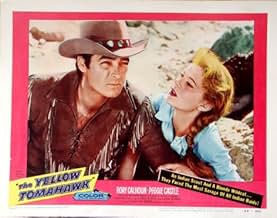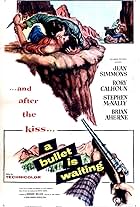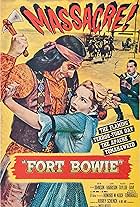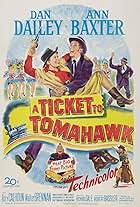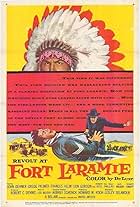When the army insists on building a fort on Indian land, in defiance of a treaty, the warnings of a scout go unheeded.When the army insists on building a fort on Indian land, in defiance of a treaty, the warnings of a scout go unheeded.When the army insists on building a fort on Indian land, in defiance of a treaty, the warnings of a scout go unheeded.
- Director
- Writers
- Stars
Noah Beery Jr.
- Tonio Perez
- (as Noah Beery)
Patrick Sexton
- Lt. Bascomb
- (as Patrick Joseph Sexton)
- Director
- Writers
- All cast & crew
- Production, box office & more at IMDbPro
Featured reviews
The Yellow Tomahawk is directed by Lesley Selander and written by Harold Jack Bloom and Richard Alan Simmons. It stars Rory Calhoun, Peggie Castle, Noah Beery Jr., Warner Anderson, Peter Graves, Lee Van Cleef and Rita Moreno. Music is by Les Baxter and cinematography by Gordon Avil.
Scout and tracker Adam Reed (Calhoun) is handed a yellow tomahawk by Cheyenne warrior Fire Knife (Cleef). It is to be given to Major Ives (Anderson) as a proclamation of war, a heed to get women and children out the way prior to attack. Ives stubbornly rejects the threat...
Another splendid 1950s Oater begging to be sought out by fans of the genre, and another reason to laud Calhoun as underrated in his time. Story wise there are familiar tropes, but it's always nice to see a screenplay sympathetic to the Native Americans, where here led by *ahem* Van Cleef they are fed up of encroachment and seek to defend their tribal lands. There is honour in the actions, which in turn solidifies a believable friendship between Fire Knife and Reed.
It's also in parts sexy, which gets its first marker during Reed and Katherine's (Castle) first meeting, god bless water! Ok! So the inevitable coupling is all a bit sudden and trite given an event previously, but the romance factor here does not hinder the depth of the screenplay. Also bonus is that Reed is not some unstoppable muscular hero, he is openly shown to be as fallible in a fight as all of us can be - twice! The makers are not here purely for comic book
There's twists in store as well, one of which is a doozy, while the action as you would expect under Selander is very competent and exciting. You will not forget the massacre sequences, where the eye for an eye - violence begets violence theme is banging the drum, while the presence of Beery and Graves is most welcome. Filmed in Colour but released to TV in black and white, a Western fan can't help lament this fact. For you can see the wonderful Kanab locations begging to be colourized. Shame that.
The messages within my grate on some, but if shrugging that off there is a whole lot for Western supporters to savour here. 7/10
Scout and tracker Adam Reed (Calhoun) is handed a yellow tomahawk by Cheyenne warrior Fire Knife (Cleef). It is to be given to Major Ives (Anderson) as a proclamation of war, a heed to get women and children out the way prior to attack. Ives stubbornly rejects the threat...
Another splendid 1950s Oater begging to be sought out by fans of the genre, and another reason to laud Calhoun as underrated in his time. Story wise there are familiar tropes, but it's always nice to see a screenplay sympathetic to the Native Americans, where here led by *ahem* Van Cleef they are fed up of encroachment and seek to defend their tribal lands. There is honour in the actions, which in turn solidifies a believable friendship between Fire Knife and Reed.
It's also in parts sexy, which gets its first marker during Reed and Katherine's (Castle) first meeting, god bless water! Ok! So the inevitable coupling is all a bit sudden and trite given an event previously, but the romance factor here does not hinder the depth of the screenplay. Also bonus is that Reed is not some unstoppable muscular hero, he is openly shown to be as fallible in a fight as all of us can be - twice! The makers are not here purely for comic book
There's twists in store as well, one of which is a doozy, while the action as you would expect under Selander is very competent and exciting. You will not forget the massacre sequences, where the eye for an eye - violence begets violence theme is banging the drum, while the presence of Beery and Graves is most welcome. Filmed in Colour but released to TV in black and white, a Western fan can't help lament this fact. For you can see the wonderful Kanab locations begging to be colourized. Shame that.
The messages within my grate on some, but if shrugging that off there is a whole lot for Western supporters to savour here. 7/10
The 1950s was the decade of the message western, and this is a low budget version of the genre. But don't let the low budget (or the deterioration of the film negative) scare you away. This story about a bloody confrontation that is the direct result of a barbarous US general's attempt to occupy Indian lands is surprisingly brutal, sympathetic to the native Americans, and much more cynical about the inherent decency of those in power than one would expect from a movie from this era. Yes, if you look, you will find ample and annoying western movie clichés. Rory Calhoun and Rita Moreno are the recognizable stars here -- and they are playing types, rather than roles. (Rory is the scout raised by the native Americans, who is conflicted. Rita Moreno has an obnoxious role as the cute native American who has attached herself to Rory's Mexican sidekick). The reason to watch is plot, pacing, and, yes, the ending that you will not predict.
Note. The film was shot in color, but TCM broadcast it in black and white. This looks like a film in bad need of restoration, particularly as much of it was shot against sagebrush that was actually in bloom.
Note. The film was shot in color, but TCM broadcast it in black and white. This looks like a film in bad need of restoration, particularly as much of it was shot against sagebrush that was actually in bloom.
Although color would have been nice for this western shot on location in Kanab, Utah, The Yellow Tomahawk is no frills, brutal, and bloody western about some survivors of a massacre trying to make it home to safety. The Cheyennes however are only retaliating for the infamous Sand Creek Massacre in which the commanding officer had a big part. The commander is Major Warner Anderson who has some real issues of his own.
Rory Calhoun and Noah Beery, Jr. play a couple of scouts who see the problem, but are helpless with Anderson's intransigence and stupidity. Anderson even after Sand Creek is now building an army fort on Cheyenne land and the Cheyenne don't take kindly to that. They send the army warning signal of The Yellow Tomahawk which is their way of saying clear out. The scenes of the massacre of the cavalry and some civilians including women is not for the squeamish.
Peggie Castle and Rita Moreno play the women paired with Calhoun and Beery. Peter Graves is a shifty gold prospector. But the film belongs to Warner Anderson, this might be his career role. You won't believe why he ordered the Sand Creek massacre, but it's actually curiously relevant to issues coming before the Supreme Court to be rendered as I write this.
Rory Calhoun and Noah Beery, Jr. play a couple of scouts who see the problem, but are helpless with Anderson's intransigence and stupidity. Anderson even after Sand Creek is now building an army fort on Cheyenne land and the Cheyenne don't take kindly to that. They send the army warning signal of The Yellow Tomahawk which is their way of saying clear out. The scenes of the massacre of the cavalry and some civilians including women is not for the squeamish.
Peggie Castle and Rita Moreno play the women paired with Calhoun and Beery. Peter Graves is a shifty gold prospector. But the film belongs to Warner Anderson, this might be his career role. You won't believe why he ordered the Sand Creek massacre, but it's actually curiously relevant to issues coming before the Supreme Court to be rendered as I write this.
As rugged Indian scout Adam Reed (Rory Calhoun) rides in the open country of Utah towards a US Cavalry outpost, he is stopped by his close friend, Cheyenne warrior Fire Knife (Lee Van Cleef). Fire Knife gives Reed a yellow tomahawk to give to the outpost commandant, Major Ives whom he and Chief Red Cloud call a "butcher" and hold mainly responsible for the Massacre at Sand Creek. That site is a real historical event (1864) where the US Cavalry killed over 100 Indians, most of whom were women and children. The yellow tomahawk is a warning – more than the Cavalry gave earlier to the Indian – for the soldiers to clear out of the planned future fort or face the consequences. The soldiers will be allowed to depart peacefully.
On his way to the military encampment, Reed spots blonde and nubile Kate Bolden (Peggy Castle) bathing and swimming in a pond. They briefly exchange words; Kate tells him that she's from Boston. At the post, arrogant commander Ives (Warner Anderson) is adamant: he has no intention of leaving, even though the encampment is in Cheyenne territory. No lover of the Indian, Ives believes that the red men are dangerous to civilization. Ives gives women (and children) a choice whether to leave for Ft. Ellis or remain. Orders are given for the men to fortify the position. When preparations are being made, Reed tells Master Sergeant Bandini (Dan Riss) that advance pickets should be placed on the hills, and that not all of the men should be placed behind the barricades. Bandini agrees but explains to Reed that he is resigned to taking orders, whether he agrees or not. The Indians soon attack, and Ives' faulty tactics manifest themselves. When the violence ends there are only nine survivors: the major, a corporal, a private, a Mexican Indian scout Tonio (Reed's friend, Noah Beery Jr.), Tonio's Indian girlfriend Honey Bear (a lovely Rita Moreno), an army engineer/surveyor, a slimy prospector (Peter Graves) who has murdered his two partners for gold, blonde Kate, and Reed.
Now the survivors must make the dangerous trek to Ft. Ellis and safety. Reed wants to keep the major alive at all costs so that he can stand trial (court martial) for provoking an Indian war. Along the way, their numbers will shrink, as will those of the attacking Indians. When Reed and Fire Knife have a parlay, the latter says he will let the dwindling survivors leave peacefully, except for Ives. Reed cannot accept this condition. So the trek continues until the inevitable conclusion.
Director Lesley Selander has directed a nice, very well-paced western. The actors are well-cast, and are given an above average script. Some sympathy is given to the Indians, who are defending their tribal lands from encroachment. There are two twists at the end that involve Major Ives; they will not be revealed here. The western was shot in Technicolor but released to television in black and white.
On his way to the military encampment, Reed spots blonde and nubile Kate Bolden (Peggy Castle) bathing and swimming in a pond. They briefly exchange words; Kate tells him that she's from Boston. At the post, arrogant commander Ives (Warner Anderson) is adamant: he has no intention of leaving, even though the encampment is in Cheyenne territory. No lover of the Indian, Ives believes that the red men are dangerous to civilization. Ives gives women (and children) a choice whether to leave for Ft. Ellis or remain. Orders are given for the men to fortify the position. When preparations are being made, Reed tells Master Sergeant Bandini (Dan Riss) that advance pickets should be placed on the hills, and that not all of the men should be placed behind the barricades. Bandini agrees but explains to Reed that he is resigned to taking orders, whether he agrees or not. The Indians soon attack, and Ives' faulty tactics manifest themselves. When the violence ends there are only nine survivors: the major, a corporal, a private, a Mexican Indian scout Tonio (Reed's friend, Noah Beery Jr.), Tonio's Indian girlfriend Honey Bear (a lovely Rita Moreno), an army engineer/surveyor, a slimy prospector (Peter Graves) who has murdered his two partners for gold, blonde Kate, and Reed.
Now the survivors must make the dangerous trek to Ft. Ellis and safety. Reed wants to keep the major alive at all costs so that he can stand trial (court martial) for provoking an Indian war. Along the way, their numbers will shrink, as will those of the attacking Indians. When Reed and Fire Knife have a parlay, the latter says he will let the dwindling survivors leave peacefully, except for Ives. Reed cannot accept this condition. So the trek continues until the inevitable conclusion.
Director Lesley Selander has directed a nice, very well-paced western. The actors are well-cast, and are given an above average script. Some sympathy is given to the Indians, who are defending their tribal lands from encroachment. There are two twists at the end that involve Major Ives; they will not be revealed here. The western was shot in Technicolor but released to television in black and white.
This western belongs to the second part of career for Lesley Selander, his best part, unlike his cheap one, during the forties. Here, with more budget, he is of course more comfortable, and without being under the lack of freedom, which is usually the bad side of a bigger budget. Producers generally remove any wish for something new, or unusual, when some directors dare something daring. Exectuves only seek the gross, and in that purpose, the key is to propose to audiences what they seek for, what they search for, and certainly not something unexpected. Such a shame. Here, with this film, and others that he made more or less in the same period, Lesley Selander makes me think of a total freedom, concerning camera angles, characters study, and above all the Indian attack over the cavalry base camp, so violent, so brutal, with shocking scenes of women slaughtered with tomahawk. Yes, this is a very effective, excellent western from a specialist. An overall atmosphere and spirit that you can't forget, especially from a grade B movie, and not a Z.
Storyline
Did you know
- GoofsWhen an officer fires a warning shot into the air to alarm the army camp that Cheyenne are attacking, the Cheyenne commence firing their own guns, which would alarm the camp, yet the officer continues to fire additional warning shots into the air, instead of firing at the attackers.
- ConnectionsFeatured in Frances Farmer Presents: The Yellow Tomahawk (1958)
- How long is The Yellow Tomahawk?Powered by Alexa
Details
- Runtime1 hour 22 minutes
- Color
- Aspect ratio
- 1.85 : 1
Contribute to this page
Suggest an edit or add missing content


